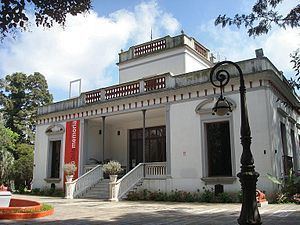 | ||
Similar Museo de la Memoria (MUME), Juan Manuel Blanes M, Centro de Memoria Paz y Re, Palacio Salvo, Pocitos | ||
Museo de la Memoria is a museum in Montevideo, Uruguay dedicated to the memory of those or died or were "disappeared" during the Uruguayan dictatorship of 1973 to 1985.
Contents
The Museum
Known by its Spanish abbreviation of MUME, the Museo de la Memoria was set up in order to commemorate the victims of crimes committed by the state, and the resistance of some Urugauyans in the face of this oppression, during the country's dictatorship. It aims to educate new generations about the country's recent history, to promote respect for human rights, and to remember the struggle for liberty, democracy and social justice. In having these as stated aims, it consciously attempts to strengthen important elements of Uruguayan national identity.
The museum opened to the public on 10 December 2007 and is run by the city government of Montevideo.
The permanent exhibition is focussed around seven key themes:
- The establishment of the dictatorship
- Popular resistance
- Prison life
- Exile
- The "Disappeared"
- The restoration of democracy and the struggle for truth and justice
- Unfinished history and new challenges
MUME is located around 9 km from the centre of Montevideo's old town.
History and Architecture of the Building
MUME is housed in a building considerably older than the museum, which dates back to 1878 when it was built as the country retreat of Uruguayan soldier and later president Máximo Santos. The house, and the parkland in which it is situated, has been declared National Historical Monument. The parkland in particular is unique to Montevideo, being the only remaining unchanged 19th Century parkland in the city.
The architectural style of the building is eclectic: though built mainly in neoclassical fashion, in its details it incorporates elements of Art Nouveau. Borrowing also from Renaissance architecture, the building uses a piano nobile, or raised ground floor, which is accessed by grand marble steps. Immediately before the steps is a fountain in the shape of a boat.
The main house is built in a horseshoe around a central patio containing another ornamental fountain.
Santos ruled Uruguay from 1882 until 1886. Shortly after leaving office, in 1887, he sold the site to Spanish businessman Emilio Reus. In 1920, the house was purchased by Lebanese immigrant Rezcala Neffa. Neffa, a rich industrialist, became a Uruguayan citizen and became a philanthropist in his adopted country. On buying the house and parkland, he gave it over to the Uruguayan Navy, which used the site as offices and workshops for the Hydrographic Service.
By the 1970s, the site had been abandoned by the Navy and fell into disrepair.
In 2000, the city government of Montevideo, by now the owner of the site, started work on restoring the derelict buildings. The project was aided by a gift of US$800,000 from supermarket chain Disco and aimed to create a site which could be used for a new cultural centre or museum, although exactly what the museum would showcase was, at that time, undecided. The restoration was completed in 2005.
The Parkland
The park is landscaped in a similarly eclectic style, borrowing from Italian Renaissance gardens, 19th Century theories of health, and European landscape architecture.
The idea of the country retreat was to combine a house for relaxation with a garden to be enjoyed. Its distance from the city centre, which is on the coast, is in line with the theory that country air was more healthy than air from the coast.
The park is around four hectares in size and contains a long tree-lined access avenue, gardens of exotic species, a greenhouse, a nursery, a folly designed for children in the shape of a castle, fountains, sculpture, artificial caves and an aviary.
